Chainsaw Length Guide: What Size Chainsaw Do You Need?
- July 4, 2023
- 2 comment
Choosing the right chainsaw size is crucial for the efficiency and safety of your cutting tasks. Whether you’re pruning small branches, chopping firewood, or felling large trees, the size of your chainsaw’s guide bar determines how quickly and effectively you can complete the job. In this guide, we’ll explain how to choose the perfect chainsaw size for your needs, so you can start your project with confidence.

At first glance, you might think that chainsaw length refers to the entire length of the chainsaw itself. However, when discussing chainsaw length, we are specifically referring to the guide bar length. The guide bar is the long metal part that guides the chain in its rotations.
The length of the guide bar essentially determines the size of the wood or tree that you can cut in a single pass. For example, a chain saw with a 20-inch guide bar can typically cut through a log of around 18 inches in a single pass.
Choosing the Right Length
When choosing the right length for your chainsaw, the rule of thumb is to opt for a guide bar length 2 inches longer than the wood you plan to cut. For instance, if you regularly work with 16-inch logs, a chainsaw with an 18-inch guide bar should suffice.
What Size Chainsaw Do I Need for My Project?
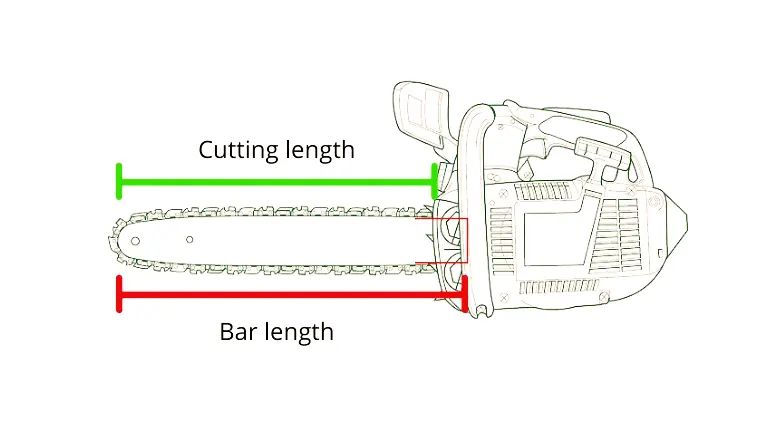
- Best Chainsaw Size for Pruning (6 to 14 inches): Chainsaws with a guide bar length in this range are perfect for light-duty tasks like pruning, trimming, and cutting small branches. They are also generally lightweight and easy to handle, making them ideal for beginners.
- Best Chainsaw Size for Firewood (16 to 20 inches): If you’re into heavier tasks such as chopping firewood, felling small trees, or clearing large branches, medium-length chainsaws would be your best bet. These chainsaws provide a good balance between cutting capacity and maneuverability.
- Best Chainsaw Size for Felling Trees (22 inches and up): For heavy-duty tasks like logging, milling, and felling large trees, you’ll need a chainsaw in this length category. However, keep in mind that these chainsaws are often heavier and more challenging to control, so they’re best left to experienced users.
| Chainsaw Size | Best for Tasks | Pros | Cons |
| 6-14 inches | Pruning, trimming small branches | Lightweight, easy to handle | Limited cutting capacity |
| 16-20 inches | Firewood cutting, felling small to medium trees | Versatile, good for most homeowner tasks | Can be heavy for prolonged use |
| 22 inches and up | Felling large trees, heavy-duty tasks | Powerful, efficient for large tasks | Heavier, requires more experience |
How to Measure Chainsaw Bar Length Correctly
Measuring the bar length of a chainsaw is a simple process that you can do in just a few steps. Here’s how you do it:
- Before you start, make sure the chainsaw is turned off and cooled down if it was in use recently. Also, it is recommended to remove the spark plug cap for extra safety.
- Start your measurement at the base of the bar where it emerges from the casing or housing of the chainsaw. This part is also known as the ‘heel’ of the bar.
- Extend your tape measure along the length of the bar, all the way to the very tip of the bar. This part is called the ‘nose’ of the bar.
- Chainsaw bars are typically measured in even numbers. Therefore, if you find that your bar measures to an odd number or a fraction, round it up to the nearest even number. This is because the industry standard is to round up to the nearest inch. For example, if your bar measures 13.5 inches, it’s considered a 14-inch bar.
Determining Chain Pitch
Chain pitch is the space between the chain links.
- Use a ruler or tape measure to find the distance between three chain rivets.
- Halve the measured distance to get the chain pitch.
- Common pitches include 1/4-in., .325-in., 3/8-in., and .404-in.
Counting Driver Links
The number of driver links is simply the total number of links on your chain.
- Spot the driver links – they appear as small protrusions inside the chain.
- Tally up the links to get the count.
Measuring Chain Link Gauge
This is the thickness of the drive links, which should align with your chainsaw bar’s gauge for a secure fit.
- Use a caliper or a general-purpose gauge for measurement.
- Position it in the groove where the chain sits on the bar.
- Note the measurement shown.
- Typical drive link gauges range from .043-in., .050-in., .058-in. to .063-in.
Safety Considerations
Selecting a chainsaw of the right length is just the first step in preparing for your cutting tasks. It’s essential to remember that even the most suitable chainsaw can pose risks if not handled safely. Here are some safety considerations you should always keep in mind:
Personal Protective Equipment (PPE)
Before operating a chainsaw, ensure you are wearing appropriate safety gear. This includes protective eyewear, gloves, sturdy footwear, and cut-resistant trousers. Consider a helmet with a face shield if you’ll be cutting overhead branches.
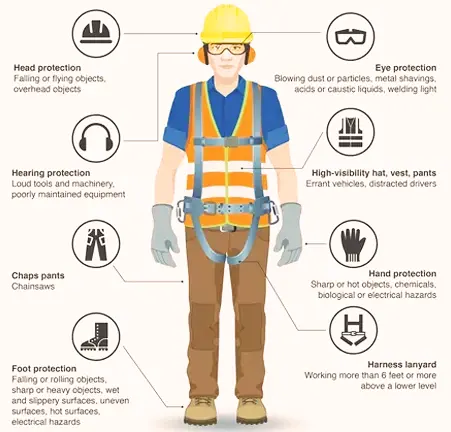
Proper Handling
Learn and practice the correct handling and operating techniques for your chainsaw. This includes knowing how to hold the chainsaw properly, maintaining a stable stance while cutting, and understanding kickback prevention.
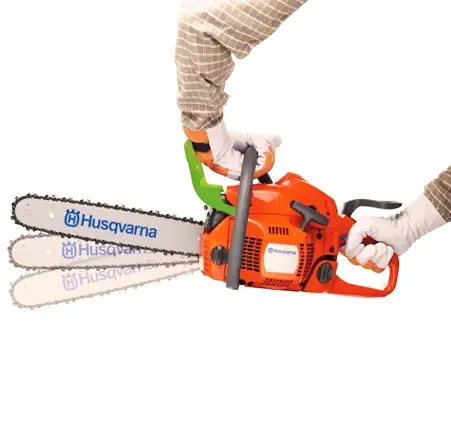
Regular Maintenance
A well-maintained chainsaw is not only more efficient but also safer. Regularly inspect your chainsaw for signs of wear and tear. Ensure the chain is sharp and correctly tensioned, the bar is in good condition, and the safety features are functioning well.
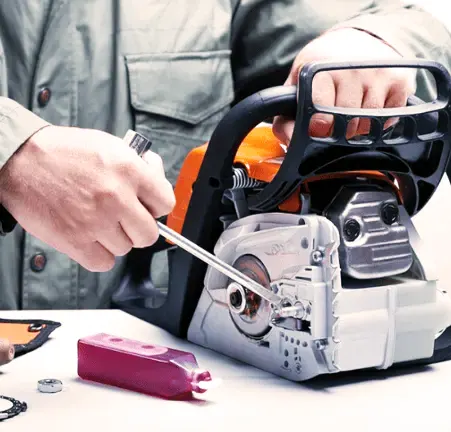
Emergency Preparedness
Accidents can still happen, even with the most careful precautions. Make sure you have a first aid kit nearby and know the quickest route to the nearest medical facility.
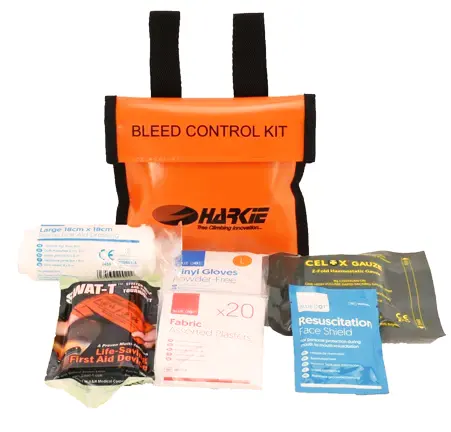
Guide to Choosing the Right Chainsaw Size
Picking the right chainsaw size not only makes cutting smoother but also ensures safety.
Chainsaw sizes differ based on their type, each tailored for specific tasks. While 12 to 20 inches are the standard bar sizes, you can find professional-grade chainsaws as long as 72 inches. Remember, a longer bar means a heavier chainsaw.
For optimal performance, select a chainsaw bar that’s at least two inches longer than the width of the material you’re cutting. Here’s a quick rundown of what each size is best for:
- Gas-Powered Chainsaws: These range from 16 to 72 inches. The 16-18 inch models are ideal for medium-sized trees. For larger trees or firewood, consider chainsaws 20 inches or longer.
- Electric Chainsaws: These are generally smaller, ranging from 14 to 16 inches. The 14-inch is perfect for smaller trees, while the 16-inch tackles medium-sized trees.
- Battery-Powered Chainsaws: Usually found in 16 to 18-inch sizes, these are great for medium tree cutting. However, there are also compact models between six to nine inches, like the Milwaukee M12 Fuel Hatchet Six-Inch Pruning Saw, perfect for trimming smaller branches.
Conclusion
In summarizing the key points of this article, it is crucial to recognize that the proper chainsaw length significantly influences the tool’s efficiency, user safety, and suitability for various tasks. The length of a chainsaw refers to the length of the guide bar, which essentially dictates the maximum diameter of a log that can be cut in one go.
The choice of the correct chainsaw length is dependent on the scope of the work and the user’s level of experience. Shorter chainsaws, ranging from 10 to 14 inches, are typically suitable for lighter tasks such as pruning or cutting small trees. Medium chainsaws, measuring between 16 to 20 inches, are more versatile, adeptly handling most homeowner tasks. Meanwhile, longer chainsaws, between 22 to 36 inches, are designed for substantial, heavy-duty tasks and are often operated by professionals.
It’s worth noting that chainsaw length is measured from the chain’s tip to the point where it enters the housing. This measurement doesn’t include the entire length of the bar, a common misconception.
Importantly, no matter what chainsaw length is chosen, paramount consideration must be given to safety precautions. This includes wearing the proper safety gear, adhering to correct handling techniques, maintaining the chainsaw regularly, and ensuring readiness for emergency situations.
To wrap up, the process of choosing the right chainsaw length extends beyond merely considering the tasks at hand. It also entails a focus on user comfort and safety. The ideal chainsaw is one that is both manageable and safe for the user, while also effectively meeting their cutting requirements. Whether you are a gardening enthusiast or a professional logger, gaining a solid understanding of chainsaw lengths and their respective uses is integral to performing a successful and safe operation.
Related Articles:
- 5 Step Plan for Safe Tree Felling with a Chainsaw
- Avoiding Common Mistakes When Using a Chainsaw
- How To Sharpen A Chainsaw Properly: Tips and Tricks
- Best Top Handle Chainsaw: Forestry Choice
- 10 Best Mini Chainsaws of 2023
Frequently Asked Questions
- What is the most common chainsaw bar length?
The most common chainsaw bar length is 16 to 20 inches. This size is popular because it’s versatile and works well for a variety of tasks, like cutting down small trees or chopping firewood, making it a great choice for both homeowners and professionals. - Can I use a longer chainsaw bar on my chainsaw?
You can use a longer bar on your chainsaw, but only if the chainsaw’s power and engine size can accommodate it. Using a bar that’s too long for your chainsaw can lead to reduced performance and potential safety risks. - How do I know if my chainsaw is too big for the task?
If you’re struggling to control the chainsaw, if it feels heavy or unwieldy, or if you’re feeling fatigued quickly, your chainsaw might be too big for the task. Remember, safety and control are paramount. - How often should I maintain my chainsaw?
It’s recommended to perform a quick check-up of your chainsaw before each use. Comprehensive maintenance, including cleaning, checking the tension and sharpness of the chain, and inspecting for any damage, should be done after every few uses or at least every few months. - Is it safe to cut with the tip of the chainsaw?
No, it’s not safe to cut with the tip of the chainsaw. This action can cause kickback, which is a leading cause of chainsaw-related injuries. Always cut with the saw running at full speed, and the saw bar positioned horizontally. - What are the signs of a dull chainsaw?
Signs of a dull chainsaw include having to force the saw through the wood, uneven or ragged cuts, sawdust that looks fine and powdery, or the chainsaw becoming hard to control. If you see these signs, it’s time to sharpen your chainsaw. - Why is chainsaw kickback so dangerous?
Chainsaw kickback is dangerous because it’s unpredictable and can happen extremely quickly, often resulting in the chainsaw moving in an opposite direction to the cut. This can lead to loss of control over the chainsaw, potentially causing serious injuries. - What size chainsaw is best for a beginner?
A beginner should start with a lightweight chainsaw, 12 to 16 inches, ideal for light tasks like trimming and pruning for better control and safety. - How do I choose the right chainsaw size for cutting firewood?
For firewood, a 16 to 20-inch chainsaw works well. It offers a balance between power and control, ideal for cutting small to medium logs efficiently. - Can I change the bar length on my chainsaw?
Yes, but only if the chainsaw’s engine can handle it. Always check the manufacturer’s specifications to avoid safety risks or performance issues.
Welcome to Chainsaw Length Guide! Your presence in our community is greatly appreciated. Feel free to take a moment and share your thoughts, experiences, and insights with us. Your contribution could be the key to assisting others who are navigating the world of chainsaw lengths. Let’s work together to make this a helpful resource for all things chainsaw-related.

David Murray
Forestry AuthorI'm David Murry, a forestry equipment specialist with a focus on chainsaw operation. With over 13 years of experience, I've honed my skills in operating and maintaining a wide range of machinery, from chainsaws to log splitters. My passion for the outdoors and commitment to sustainable forestry drive my work, which emphasizes safety, efficiency, and staying updated with industry advancements. Additionally, I'm dedicated to sharing my expertise and promoting environmental awareness within the forestry community.
2 comments
I was taught by Jonsered, Husky, and Stihl about 10% open face notch, 10% hinge, always evaluate direction of fall by limbs, wind and where it will land prior to starting saw. Always start saw and check chain bread every time I start it. Never fuel or sharpen a hot saw, always have a spotter, hammer and wedges with you when felling. Hold bar tip straight up, if you can see the edge of teeth it is dull.


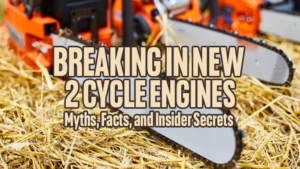









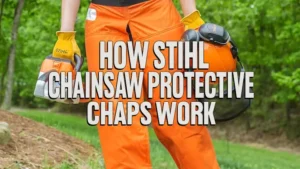
Thanks for the informative guide on chainsaw length! It definitely helps to clarify which chainsaw is right for the job. The article mentions that longer chainsaws are better suited for larger trees. Does there come a point where a chainsaw gets too long or too heavy to be effective? Perhaps there are techniques for using a longer chainsaw safely?
Andrew Robins
September 20, 2024 5:10 pm